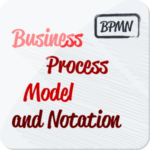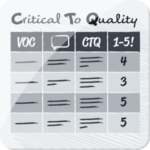
1-to-1 Interview
The one-to-one interview is, besides the focal group interview, another way of personal questioning in primary market research to raise data and evidence.

Benchmarking
Benchmarking is a tool to determine the best out of many different objects which can be further used as a reference object for optimization. Therefore, it is necessary to identify better methods and practices (best practices) by comparison. Those have to be understood, adjusted to one’s own situation, and integrated.

BPMN
BPMN (=Business Process Model and Notation) is a method to model processes graphically in a standardized way. The standard includes a guideline that regulates the look of components of the process illustration (notation). Furthermore, possible connections between those components are standardized (syntax) as well as their meaning (semantics).

Change Architecture
The “change architecture“ is a precisely elaborated and coherent “end-to-end” change concept – from the first announcement, to the accomplishment of critical phases, up to the successful completion. It has a consistent logic which explains how the planned procedure leads to the changes targeted.

Control chart
The control chart is a graphical description of measured values for monitoring process variance and variation.

CTQ-Table
CTQ is a service or product feature that satisfies the key requirements of a customer. Single CTQs are summarized in the CTQ-Table. This table is partially based on the VOC plan.
CTQ = Critical to quality
VOC = Voice of customer

FMEA
The failure mode and effect analysis is to be applied as an instrument for failure prevention. FMEAs have to be developed in coordination with the responsible engagement partners during development and manufacturing of goods, in case of new manufacturing processes, for safety relevant and other problem parts.

Focus group interview
The focus group is a moderated discussion group within a peer group tracking an open question. The focus lies on the discussion in terms of a qualified feedback (a qualified feedback provides information to the participants what has been made and why).

Kano model
The Kano model shows the interrelation between customer satisfaction and the fulfilment of customer demands. The customers are categorised into three groups. The non-fulfilment of the requests has varying influence on customer satisfaction. The model can be applied to employee satisfaction as well.

Lineup
The (systematic) lineup intends to clarify structures and relationships in a system. It triggers perception and reflection processes that can change dynamics within a group and can be helpful for conflict situations and for situations where decisions are required.
